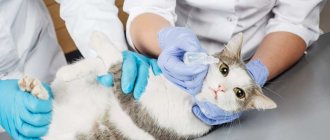Home » Useful Information
The sight of a cat itching furiously should alert the owner, since the animal never does this for no reason. Quite often, the cause of this phenomenon is infection with the microscopic ectoparasite Notoedres cati, which parasitizes the upper layers of the epidermis of mammals. The invasive disease it causes is called notoedrosis (pruritic scabies).
- 2 The danger of scabies
2.1 Can a person get scabies from a cat?
- 3.1 Video: scabies in a cat
- 4.1 Video: Notoedres cati mite under a microscope
- 5.1 Video: subcutaneous mites in cats
What is cat scabies?
Cat scabies is an animal skin disease caused by parasitic organisms. The disease is caused by these types of ticks:
- Sarcoptes canis. The organisms cause pruritic scabies (sarcoptic mange). The locations of the lesions are different parts of the body. The disease most often affects dogs, but cases of infection in cats are also not uncommon.
- Notoedres cati. Mites cause head scabies (notoedrosis). This cat disease is one of a number of common diseases.
Important! The disease also occurs due to ear mites. Scabies in this case is called otodectosis.
Scabies mites under a microscope
Ticks that live in your pet's skin cause discomfort, which forces the cat to scratch the lesions. Symptoms of the disease become apparent 2-3 weeks after infection.
This is interesting: What to do if your cat is bleeding from the mouth?
Biology of the parasite
The tick is not able to exist for a long time outside the cat. Under favorable conditions (high humidity and temperature 7–10 °C), it remains viable for no more than a decade. The parasite lives in a layer of skin rich in nerve endings. Therefore, the movement of arthropods causes unbearable itching in the cat.
- Papillomas and warts in cats
- Why does my cat's belly go bald?
Females gnaw tunnels, tens of millimeters long, through which they climb to the surface of the skins. The insect lays eggs inside the passages and dies. 3–8 days after laying, the larvae hatch and, having reached 2–3 weeks, become sexually mature. The Notoedroz mite parasitizes cats of all ages and breeds. Transmission occurs through contact or through household items.
Life cycle of notoedres cati
The life cycle of the mite that causes cat scabies is a maximum of 3 weeks. Organisms can only live in the victim's skin. They periodically climb to its surface to lay eggs. The larvae emerge from the eggs in about 4-7 days.
Developmental cycle of Sarcoptes canis
Clinical picture
The disease develops gradually. The first symptom is itching, as active females, penetrating the skin, immediately begin to gnaw the passages to feed. There are no other external manifestations, but the cat is constantly itching at the site of parasite penetration. Sometimes papules appear at the site of mite penetration, but they are difficult to notice under the fur.
Constant scratching leads to skin injuries and partial alopecia. Gradually, if the wounds are not treated, a secondary bacterial infection joins acariasis.
Usually the first external symptoms become noticeable in the head area.
As the parasite invades new areas of the skin, the previously affected areas develop a characteristic lesion:
- the upper layer of the epidermis becomes thick and dry;
- Dense crusts appear in places where scratching and parasite penetration occur.
In advanced cases, skin symptoms are accompanied by signs of damage to the immune system: the lymph nodes closest to the site of parasite activity enlarge, and the temperature may rise. Without proper treatment, skin necrosis is possible, which can lead to sepsis and death of the animal.
Symptoms of notoedrosis in humans are not so pronounced and are limited to itching: since Notoedres cati does not reproduce on human skin, the degree of damage is usually insignificant. A greater danger to people is secondary infection: ticks can introduce opportunistic microorganisms that are abundantly present on the skin of cats. In the external environment, these bacteria are relatively harmless, but when they get inside the human body, they can cause serious problems.
The danger of scabies
Damaging various layers of the epidermis in the process of its life, the ectoparasite simultaneously touches the nerve endings, which causes severe itching and irritation. The animal itches incessantly and further injures the lesions. The inflammatory process involves deeper layers of the skin, as a result it thickens and cracks, and hair falls out.
A secondary infection penetrates into the affected areas, purulent abscesses and ulcers appear. In particularly advanced and severe cases, skin necrosis and sepsis are possible. The central nervous system suffers, and the functions of blood vessels and the heart are also impaired. Condensation of the submandibular lymph nodes is detected, and body temperature rises.
Severe tick infestation is very dangerous for the health of the animal.
Outside the body of its permanent owner, in this case a cat, a tick can remain viable for more than 10–12 days (at a temperature of about +15…+20 °C).
Can a person get scabies from a cat?
Notoedrosis can also be transmitted to humans, since this disease, called pseudoscabies in the case of humans, is extremely contagious . Arthropods infect the skin on the abdomen, neck, arms and legs. But since they fail to lay eggs and reproduce on the thick-skinned human body, the disease goes away on its own at the end of the parasite’s life cycle. Symptoms disappear after about 3-4 weeks even without treatment. Therapeutic measures can significantly reduce this period.
Some danger is posed by the possibility of infection with secondary infections that are present on the skin of cats and are carried by ticks.
Treatment of cat mange
After the diagnosis is made, the sick animal is isolated in a separate room. The goal of treatment for notoedrosis is to free the cat’s skin from ectoparasites and help restore the epidermis. Depending on the severity of the disease, the veterinarian prescribes drugs for systemic or local treatment. It is carried out on all animals in the group where the sick cat is found. It doesn't matter if they show signs of notoedrosis infection.
Adult animals are treated for a month with subcutaneous injections of ivermectin at a dosage of 0.04–0.1 ml per 1 kg of pet weight. The interval between injections should be at least seven days. Ivermectin is very toxic, so weak cats are given a minimal amount.
In case of overdose, drugs containing ivermectin can cause increased salivation, nausea, and increased urination and bowel movements.
If the use of injections is not practical, the veterinarian prescribes acaricides in the form of drops on the withers. Selamectin in a proportion of 0.1 mg per 1 kg of body weight is applied to the skin in the neck area. The affected areas are treated twice with an interval of 8–12 days.
To destroy mites that cause notoedrosis, the combined drug Advocate is also used. It contains two active ingredients: imidacloprid 10% and moxidectin 1%. A small dose is also effective - 0.1 ml per 1 kg of animal weight. After four weeks from the moment of application, the pet recovers completely.
Unfortunately, these drugs contain neurotoxic poisons. They are contraindicated for pregnant and lactating cats. Therefore, local treatment is used to rid animals of head scabies.
Treatments for notoedrosis lesions in cats include:
- Aversectin ointment;
- Demos liniment;
- Amidel gel.
Before treating with acaricides, the cat is washed with shampoo to soften and remove scabs. Then the hair on the infected areas of the skin is cut off. The medicine is applied with a glass spatula to the damaged areas, moving from the edges to the center. Apply to healthy skin up to 1 cm near the lesion. The procedure is repeated after 5–7 days. For clinical effect, it is enough to use the ointment 2-3 times. After examining two skin scrapings with a negative result, the pet is considered recovered. The damaged fur will fall out, and a new one will grow thick and soft.
In the post-war period, thousands of people suffered from scabies, saving themselves with a simple sulfur ointment, which they used to treat themselves and their pets. To treat adult cats, the ointment is diluted with petroleum jelly in a ratio of 1:2, for small and weak cats - 1:4, then the hands are lubricated with the prepared product so as not to become infected with ticks, and the remaining mixture is placed on a bag or plastic lid so that it is convenient to take it with one hand . Next, holding the animal, slowly and thoroughly rub the medicine into the affected areas, gently smear it near the eyes and nose. Further therapy is to provide the cat with rest and good nutrition. After three days, the treatment is repeated and then the ointment is washed off with warm water and soap.
How to treat kittens
Ivermectin and most acaricides are toxic to kittens under 4 months of age. There are known cases of babies dying after injection. They develop paralysis and coma, so they are treated for notoedrosis only with local therapy.
The dose is calculated based on the weight of the pet - 0.2 mg of the drug per 1 kg of kitten’s body weight. If the permissible amount of ointment is not enough for a single treatment, then first it is applied to larger areas of the lesion. The product is thoroughly rubbed into the skin. After 2–4 hours, the medicine is removed with a cotton swab or the kitten is washed with shampoo. Baby soap that does not irritate the skin is also suitable. After the hair has dried, the ointment is applied to the remaining areas of notoedrosis. If necessary, the drug is washed off again. This is done to reduce the impact of the drug components on the kitten’s body.
How to care for a sick animal
During the treatment period, it is better to place the sick animal in a spacious carrier or cage. It contains a tray, cups for food and water. Enhanced nutrition with added vitamins and fatty acids will increase resistance to disease. Grooming a cat wearing gloves. To prevent your pet from licking the drug and scratching its skin, a protective collar is placed around its neck. If this is not possible, the cat’s jaws are tightened with a strip of fabric before treatment with medications. It is removed 2 hours after applying the ointment. On the first day after the start of treatment, the cat’s condition worsens due to poisoning by dead ticks, so they try not to disturb the animal and dim the lighting in the room.
Isolating a cat with notoedrosis will prevent infection of other pets
The success of treating notoedrosis in cats depends on both the medications used and proper cleaning of the room:
- the floor surface is washed by adding disinfectants;
- furniture is vacuumed or treated with acaricide spray;
- pet care items are replaced or washed and ironed with a hot iron. If things cannot be wetted, they should be placed in direct sunlight.
With this treatment, the ticks quickly die.
This is interesting: Why does a cat sneeze?
Signs of scabies
The first symptoms of notoedrosis are hair loss. The animal is exhausted by itching in the ear area. After this, itching begins all over the head. Sometimes mites spread over the entire surface of the abdomen. In this area, the skin is very tender and tasty for parasites. The habit of cats sleeping curled up in a ball helps them move into this zone.
Since notoedrosis infection occurs quickly, the skin becomes thick and gray or yellow crusts appear. The animal damages its skin and often introduces other infections into the wounds, which receive a favorable environment for development. It is not surprising that notoedrosis in cats can lead to quite serious consequences. The skin becomes numb and dies.
Can a person get notoedrosis from a cat?
The tick can “move” from the pet to the owner, but will not be able to reproduce on the human body. Scabies in humans caused by cat mites goes away within about a month after the first symptoms if left untreated. The use of medications significantly speeds up the healing process.
A treatment regimen should be drawn up with a dermatologist. Typically, a specialist recommends topical medications that eliminate itching and have a detrimental effect on mites. In some cases, medications are prescribed for internal use.
A tick can “move” from a cat to a person
Attention! Despite the fact that notoedrosis goes away without treatment, you should not ignore a visit to the doctor. There is a high risk of mutation and negative consequences after the course of the disease.
Ways of infection with notoedrosis in cats
Cat scabies is a contagious disease. Ticks can penetrate your pet's skin after these manipulations:
- Contact with an infected animal. Harmful organisms are easily transferred from one pet to another. This often happens on the street, at exhibitions, in pet stores, veterinary offices and nurseries.
- Contact with an infected person. Ticks easily move from cat to cat and from pet to person.
Important! An animal can also become infected through domestic means. For example, after using a hair brush that got ticks from a sick cat. Carpets, bedding and floor coverings are items that can also temporarily harbor parasites.
Cat affected by notoedrosis
The younger the animal is, the more susceptible it is to infection. The highest risk group includes young individuals.
Symptoms
A number of clinical signs are characteristic of feline scabies:
- Itching . The animal itches, bites itself, rubs against objects. His behavior becomes restless.
- Papules with a crust . These changes in the epidermis are a consequence of the presence of ticks in it.
- Peeling . The scratched skin becomes covered with crusts. It becomes thicker, folds appear on it.
- Baldness . The hair on the combed areas gradually falls out.
Itching in a cat is one of the signs of notoedrosis.
If left untreated, notoedrosis turns into sarcoptic mange, that is, not only the head, but also the entire body of the pet is affected. The following are possible serious complications:
- Loss of appetite . The animal's body is exhausted. The pet may also refuse water.
- Infection . A cat can acquire other serious diseases through the entry of pathogens through breaks in the epidermis.
- Rotting of the skin and damage to other organs . The prognosis for treatment after these changes is rarely favorable.
Important! If you do not treat an animal that is actively developing notoedrosis, it will quickly die.
A cat with advanced stages of notohedrosis
Prevention measures
Prevention of notohedrosis is as follows:
- Exclusion of pet walks and direct contact with street cats.
- Regular treatment of the animal with drugs against skin parasites (it is better to use Stronghold).
- Do not allow your cat to come into contact with objects that have been touched by a pet infected with notoedrosis.
If strange scabs or blisters appear on your pet's skin and the animal is scratching them furiously, you should contact your veterinarian. Notoedrosis can be successfully treated, but for this it is necessary to detect the development of the disease in time.
( 2 ratings, average 4.5 out of 5 )
Treatment methods
Treatment of notoedrosis in cats is a scheme of several stages. Each of them has its own characteristics, which have a beneficial effect on the pet’s condition and prevent the progression of the disease. Before using medications, you should consult your veterinarian.
Before treatment, be sure to consult a veterinarian
Preparatory stage
In order for medications to be as effective as possible, several preparatory procedures need to be carried out:
- Washing a cat with anti-seborrhea shampoo. This action is necessary to remove dead skin particles and disinfect it. Shampoo must be purchased in special stores with goods for animals.
The most common remedies against soberia in cats
- A haircut . The manipulation prevents the formation of wounds when removing matted hair from animals. It also makes it easier to apply topical medications. The procedure is especially necessary for cats with long hair.
- Removing crusts with tweezers . Large dead skin particles should be removed to prevent the animal from biting or scratching itself. You need to act as carefully as possible so that the cat does not injure itself on the tweezers or bite a person in self-defense.
Places under which there was a crust must be treated with disinfectant compounds (potassium permanganate solution, etc.).
Local therapy
Topical products eliminate itching, act directly on mites, disinfect and improve the condition of the epidermis. The table shows drugs suitable for the treatment of notoedrosis and methods of their use.
| Medicine | Image | Mode of application |
| "Spot-on" | Apply to the withers once every 2 weeks. Duration of the course – from 2 months until complete recovery | |
| "Stronghold" | The product is applied once a day to the affected areas until recovery | |
| "Fosmet" (0.09%), "Amitraz" (0.05%) | Lesions are treated with drugs 3 times a day for 2 weeks |
Attention! When applying the compositions, you should avoid the mucous membranes and the oral cavity. Getting the medicine into your eyes is especially dangerous. If the medication gets into the mouth or eyes, it is necessary to rinse these areas of the pet.
Systemic therapy
Systemic treatment products are used only after consultation with a veterinarian, since their improper use is dangerous to the cat’s health. Before prescribing them, the specialist assesses the pet’s condition and determines the presence of possible contraindications.
Ivermectin is a suitable drug. It is used as an injection. The duration of the course and dose are determined by the veterinarian.
Step-by-step instructions for treating notohedrosis in cats
Adjuvant therapy
When a pet gets sick, its immunity is significantly reduced. To increase the protective properties of the body, the cat needs to be given balanced healthy food, vitamin and mineral complexes and feed sulfur.
If your cat is restless and constantly itching, you can help her with sedatives. A suitable medicine is Prednisolone. Directions for use: half a milligram per day. Course – 3 days.
Disinfection of the habitat
It is better to replace cat rugs and bedding. You can also wash them in hot water with disinfectants. Until your pet recovers completely, you need to wash the floors daily with water and insecticides. It is advisable to remove carpets.
Video - Subcutaneous mites in cats
Infection
Infection occurs no matter what color, breed, size or age the animal is. There is no differentiation according to females, kittens or males. Symptoms of notohedrosis are often detected in cats. As a rule, pets become infected from wild relatives on the street through contact. There are also cases of transmission of notoedrosis through care products. In addition, the cat pathogen is dangerous for such animals as :
- dogs,
- rabbits,
- foxes.
© shutterstock
Some argue that notoedrosis is dangerous for people. Unfortunately it is so. Although ticks die in the human body within a month, they can cause significant harm to children and the elderly, those with weakened immune systems. And the symptoms of notohedrosis themselves will be unpleasant for anyone - both animals and humans.
Diagnostics
Diagnosis of scabies in cats involves a number of stages:
- Initial home inspection . The owner needs to assess the pet’s condition and identify the presence of all symptoms of the disease.
- Initial examination by a specialist. The veterinarian examines the pet without the use of special laboratory equipment.
- Laboratory research . The veterinarian takes a scraping from the cat's skin to examine it under a microscope.
Attention! Trial treatment also refers to diagnostic methods. It is especially relevant at the beginning of the development of the disease. Its essence is monitoring the cat’s condition during its treatment with standard medications.
Examination of scrapings from the skin of a cat
In most cases, diagnosing notohedrosis is a quick process, as the parasites are very easy to detect. It is especially easy to make an accurate diagnosis during the progression of the disease.
For what reasons does it develop?
Scabies in cats is caused by mites. Their bites cause an itching sensation, causing the pet to scratch and scratch the skin. Often parasites remain on the cat’s body for a long time, but signs of scabies do not appear.
The development of a pathological process can be provoked by:
- dermatological diseases of any etiology;
- violation of the integrity of the skin;
- a weakened immune system due to lack of nutrients, another illness, or taking harsh medications;
- young age (up to 2 years);
- contact with sick animals.
Drugs
A very effective drug for notoedrosis is aversectin ointment. It is able to effectively eliminate tick-borne lesions. The infected areas are smeared with this medicine using a medical spatula. This procedure is repeated every other week. The dosage is agreed exclusively with the pet's attending physician . This way the situation will not worsen and there will be no side effects.
© shutterstock
Some veterinarians suggest using Stronghold drops for notoedrosis. The advantage of this drug is that the parasite becomes paralyzed. Damage to the nervous and immune systems in pets is minimized. But the medicine is not suitable for kittens that are less than six months old.
Is it possible to get a disease from a pet?
This is a contagious disease that can be transmitted from one animal to another. It is possible to say that its causative agent is dangerous for humans only conditionally, since notoedrosis cati is not adapted to exist on human skin. If the parasite gets on it, the temporary host begins to develop pseudo-scabies, accompanied by peeling, redness and severe itching. Under such conditions, bloodsuckers do not reproduce and soon die, and the person heals on his own after about 21–28 days.
Children, the elderly and those with weakened immune systems can be seriously affected by these parasites. Even if cat scabies is not dangerous for humans, in any case it brings a lot of trouble to him, so it is important to isolate the sick pet.
Treatment
It should be said right away that treatment of cats cannot be carried out with the same drugs that are used in therapy for dogs. The fact is that cats are much more sensitive and such drugs will be dangerous for them. The therapy itself often begins with hair removal, especially for long-haired cats.
The animal must be bathed in medicated shampoo. After bathing, the skin is smeared with a special ointment prescribed by the veterinarian. Sometimes it is important to use sedatives. The ointment is applied daily. Therapy can last up to eight weeks. This means that treatment requires strength and patience from the animal owner.
To prevent other pets from having the Notoedres cati tick in their bodies, it is recommended to separate the sick cat from other animals. The same applies to humans. It is better to use an isolated room. If possible, isolation is carried out for the entire course of treatment for notoedrosis - eight weeks . Experts recommend taking photos of the affected areas to compare the course of the disease every five to seven days.











